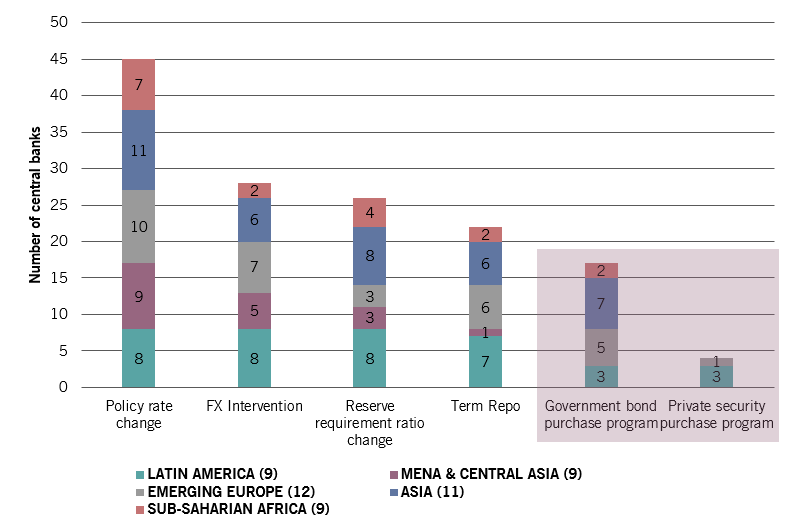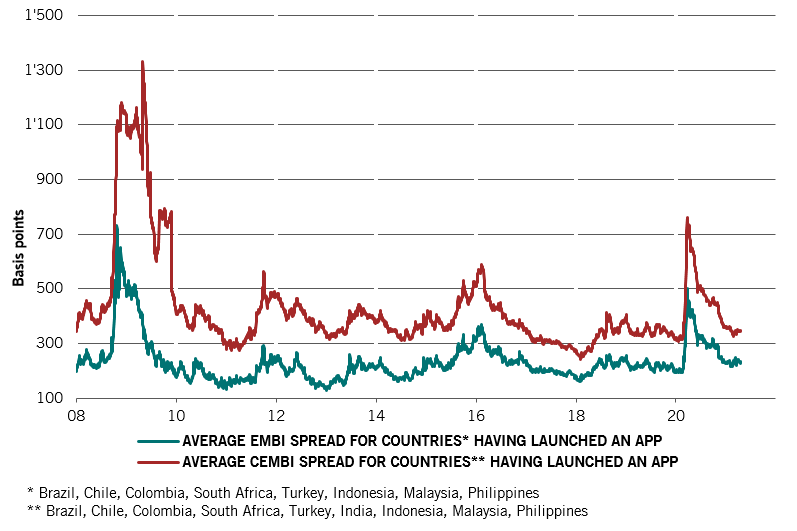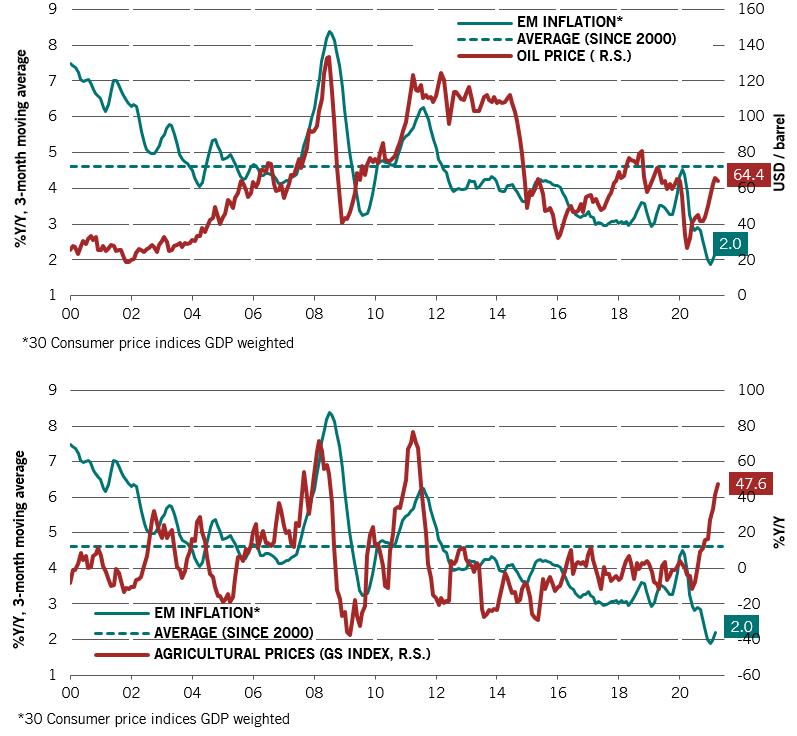[1] Source: Pictet Asset Management, IMF Global Financial Stability Report of October 2020, looking at local stress indices of APP vs. non-APP economies.
[2] Source: Pictet Asset Management, IMF Global Financial Stability Report, October 2020
[3] Source: Refinitiv, Pictet Asset management, April 2021
Select your investor profile:
This content is only for the selected type of investor.
Individual investors?
Has quantitative easing become emerging markets’ new saviour?
Emerging markets started exploring quantitative easing last year, in the midst of the Covid-19 economic crisis. Does this mean QE is now part of the monetary tools? What are the benefits and risks?
Emerging markets (EMs) are turning to Quantitative Easing (QE) in the face of the current economic crisis.
With signs of rising inflation, especially in food and commodities, several EM central banks are initiating a tightening cycle. Brazil, Turkey, Russia and Ukraine all recently hiked policy rates. As illustrated in Fig.1 below, changes in policy rates are the main tool used by EM central banks to manage inflation, growth and financial stability.
But since the start of the crisis in March 2020, QE has also been deployed in more than 15 emerging countries (Fig.1). In most cases, the size of those schemes remains limited (<5 per cent of GDP2). By way of comparison, the balance sheet of the US Federal Reserve doubled in 20203. We however expect QE to remain in EM central banks’ toolbox.
17 EM central banks have used QE measures since the start of the COVID-19 crisis in 2020.
Fig.1 - Measures taken by central banks across emerging markets

A new tool for EMs, but already some success
EM countries have been using QE to stabilise financial markets, finance fiscal spending in the context of the Covid-19 crisis and compensate for a fall in foreign investments. This has had some success.
Currencies of countries that resorted to asset repurchasing programs (APP) were stabilised earlier and to a larger extent than those of countries which did not opt for APP1. But the effects of EM central banks using QE can also be observed on bonds spreads and inflation.
- Sovereign and corporate bonds
Countries which have rolled out APP now see the spreads on their sovereign and corporate debt back to almost pre-crisis levels, now averaging 228 bps and 342 bps respectively (Fig.2). That was achieved in a context where central banks were lowering their policy rates.
Another positive effect is the fact that spreads at the peak of the crisis in March 2020 remained well below those reached during the Global Financial Crisis, when only developed economies explored QE measures.
Benefits of QE by some EM central banks can be seen through the spreads of their sovereign and corporate debt
Fig.2 - EMBI and CEMBI spreads for countries that used QE over the past year

- Inflation
Inflation is the main risk associated with quantitative easing measures. Current levels are low (Fig.3), below targets for most EM countries, giving central banks some room for manoeuvre. With lockdown measures still in place in many countries, demand and inflationary pressures remain limited.
Concerns however come from food and commodities inflation, due to supply chain disruptions and strong demand for commodities. This has led some central banks to raise interest rates.
EM inflation remains low, except for commodities (oil) and food
Fig.3 - (top chart) EM inflation and oil price growth & (bottom chart) EM inflation and agricultural prices index growth

So, will emerging markets continue to use QE measures?
We think emerging market central banks will continue to use quantitative easing, but the scope and size of these programs should be limited.
QE was able to smooth financial markets volatility, without creating significant inflationary pressures so far or risk central banks’ credibility and independence. Inflation is still low in most emerging markets, but meeting inflation targets will be an absolute priority for central banks.
An early tightening in developed economies – especially from the Fed – would prompt emerging market central banks to raise interest rates to ensure an orderly functioning of financial markets (fund flows and currencies). The use of further QE measures would however depend on the economic context of each country.
More on this topic

The inflation conundrum
The prospect of a sharp pick-up in inflationary pressures is beginning to concern investors. Our historical analysis sheds light on how stocks, bonds and other asset classes behave during periods when inflation takes hold.
April 2021

QE in emerging markets - A new era?
In the face of the current economic crisis, emerging markets (EM) are turning to QE for the first time. Our economists look at the measures announced so far and the associated risks.
April 2020
Important legal information
This marketing material is issued by Pictet Asset Management (Europe) S.A.. It is neither directed to, nor intended for distribution or use by, any person or entity who is a citizen or resident of, or domiciled or located in, any locality, state, country or jurisdiction where such distribution, publication, availability or use would be contrary to law or regulation. The latest version of the fund‘s prospectus, Pre-Contractual Template (PCT) when applicable, Key Information Document (KID), annual and semi-annual reports must be read before investing. They are available free of charge in English on www.assetmanagement.pictet or in paper copy at Pictet Asset Management (Europe) S.A., 6B, rue du Fort Niedergruenewald, L-2226 Luxembourg, or at the office of the fund local agent, distributor or centralizing agent if any.
The KID is also available in the local language of each country where the compartment is registered. The prospectus, the PCT when applicable, and the annual and semi-annual reports may also be available in other languages, please refer to the website for other available languages. Only the latest version of these documents may be relied upon as the basis for investment decisions.
The summary of investor rights (in English and in the different languages of our website) is available here and at www.assetmanagement.pictet under the heading "Resources", at the bottom of the page.
The list of countries where the fund is registered can be obtained at all times from Pictet Asset Management (Europe) S.A., which may decide to terminate the arrangements made for the marketing of the fund or compartments of the fund in any given country.
The information and data presented in this document are not to be considered as an offer or solicitation to buy, sell or subscribe to any securities or financial instruments or services.
Information, opinions and estimates contained in this document reflect a judgment at the original date of publication and are subject to change without notice. The management company has not taken any steps to ensure that the securities referred to in this document are suitable for any particular investor and this document is not to be relied upon in substitution for the exercise of independent judgment. Tax treatment depends on the individual circumstances of each investor and may be subject to change in the future. Before making any investment decision, investors are recommended to ascertain if this investment is suitable for them in light of their financial knowledge and experience, investment goals and financial situation, or to obtain specific advice from an industry professional.
The value and income of any of the securities or financial instruments mentioned in this document may fall as well as rise and, as a consequence, investors may receive back less than originally invested.
The investment guidelines are internal guidelines which are subject to change at any time and without any notice within the limits of the fund's prospectus. The mentioned financial instruments are provided for illustrative purposes only and shall not be considered as a direct offering, investment recommendation or investment advice. Reference to a specific security is not a recommendation to buy or sell that security. Effective allocations are subject to change and may have changed since the date of the marketing material.
Past performance is not a guarantee or a reliable indicator of future performance. Performance data does not include the commissions and fees charged at the time of subscribing for or redeeming shares.
Any index data referenced herein remains the property of the Data Vendor. Data Vendor Disclaimers are available on assetmanagement.pictet in the “Resources” section of the footer. This document is a marketing communication issued by Pictet Asset Management and is not in scope for any MiFID II/MiFIR requirements specifically related to investment research. This material does not contain sufficient information to support an investment decision and it should not be relied upon by you in evaluating the merits of investing in any products or services offered or distributed by Pictet Asset Management.
Pictet AM has not acquired any rights or license to reproduce the trademarks, logos or images set out in this document except that it holds the rights to use any entity of the Pictet group trademarks. For illustrative purposes only.
